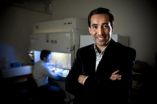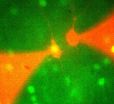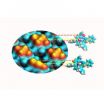(Press-News.org) Research by engineers and cancer biologists at Virginia Tech indicate that using specific silicon microdevices might provide a new way to screen breast cancer cells' ability to metastasize.
An image of their work provided to Biomaterials was selected as one of the 12 best biomaterials-related images published in the journal's 2010 catalogue. http://www.elsevierscitech.com/pdfs/Biomaterials_2010.pdf
The Virginia Tech researchers are: Masoud Agah, director of Virginia Tech's Microelectromechanical Systems Laboratory (MEMS) Laboratory in the Bradley Department of Electrical and Computer Engineering; Jeannine Strobl, a research professor in the Bradley Department of Electrical and Computer Engineering; Mehdi Nikkhah of mechanical engineering; and Raffaella DeVita of engineering science and mechanics and the director of the soft biological systems laboratory. Nikkhah was Virginia Tech's Outstanding Doctoral Student in the College of Engineering for 2009.
Their work appeared in two journal articles they authored in 2010 issues of Biomaterials, titled "Actions of the anti-cancer drug suberoylanilide hydroaxamic acid (SAHA) on human breast cancer cytoarchitecture in silicon microstructures," and "The cytoskeletal organization of breast carcinoma and fibroblast cells inside three dimensional isotropic microstructures." http://www.elsevier.com/wps/find/journaldescription.cws_home/30392/description
Cell cytoskeleton refers to the cell's shape and its mechanical properties, Agah explained. "Any change in the cytoskeletal structure can affect the interaction of cells with their surrounding microenvironments. Biological events in normal cells such as embryonic development, tissue growth and repair, and immune responses, as well as cancer cell motility and invasiveness are dependent upon cytoskeletal reorganization," the electrical engineer added.
Understanding how the cell interacts with the contents of its surrounding environment inside the human body, including the introduction of a drug, is a fundamental biological question. The answers have implications in cancer diagnosis and therapy, as well as tissue engineering, Agah said.
In previous experimentation by others in the field, researchers have exposed cells to mechanical, chemical and three-dimensional topographical stimuli. They recorded the cells' various responses in terms of migration, growth, and ability to adhere. Also, in the past, researchers have created substrates of precise micro- and nano-topographical and chemical patterns to mimic in vivo microenvironments for biological and medical applications.
What distinguishes the work of Agah, a National Science Foundation (NSF) CAREER Award recipient, and his colleagues, is they developed a specific three-dimensional silicon microstructure for their work. Due to its curved isotropic surfaces, they were able to characterize and compare the growth and adhesion behavior of normal fibroblast and metastatic human breast cancer cells, they reported in Biomaterials.
"In invasive breast carcinoma, tumor cells will fill a milk duct, and the basement membrane," they wrote. This action allows the carcinoma cells and the fibroblast cells of the breast tissue to be in close proximity, constituting "a critical pathobiological transition that leads to the progression of the disease," Strobl said.
Using their uniquely designed three-dimensional silicon microstructure, they were able to incorporate three key cellular components found in any breast tumor microenvironment. Additionally, they were able to determine the detailed interaction of the cells within this environment, including the normal breast cells, the metastatic breast cancer cells, and the fibroblast cells.
Their understanding of the behavior of the cells within the microstructures is what leads them to believe their research could "provide important diagnostic and prognostic markers unique to the tumor, which could ultimately be used to develop new tools for the detection and treatment of cancer."
Following their initial findings, Strobl, Nikkhah and Agah identified a unique application of the experimental anti-cancer drug SAHA in their studies with the silicon microstructure. SAHA, also known as Vorinostat, is the first drug of its type to receive Food and Drug Administration approval for clinical use in cancer treatment.
Unlike many of the conventional cytotoxic chemotherapy agents that target DNA to kill cancer cells, SAHA's unique properties include its ability to inhibit a family of enzymes referred to medically as "histone deacetylases." These enzymes are known to "increase levels of acetylation of many proteins, including beta-actin, alpha-, and beta-tubulin, and additional actin binding proteins comprising the cytoskeleton.
"The role of drugs such as SAHA in the control of cancer cell metastasis is only beginning to be understood," explained Strobl, "however our work shows that SAHA elicits a very characteristic cytoskeletal alteration specifically in metastatic breast cells that provides a handle for predicting which breast cells in a cell mixture might have the ability to metastasize."
Cell motility is "one hallmark of metastatic cancer cells involving the coordinated actions of actin and other cytoskeleton proteins," Agah explained. When metastatic disease develops, it is usually fatal.
They found SAHA caused cancer cells to stretch and attach to the microstructures through actin-rich cell extensions. By contrast, control cells conformed to the microstructures. This result allowed them to "conclude that isotropically etched silicon microstructures comprise microenvironments that discriminate metastatic mammary cancer cells in which cytoskeletal elements reorganized in response to the anti-cancer agent SAHA."
The Virginia Tech work in this area "is the first to address the use of microdevices to study this emerging class of anti-cancer agents," Agah said.
INFORMATION:
Early investigations promising for detecting metastatic breast cancer cells
2011-01-11
ELSE PRESS RELEASES FROM THIS DATE:
Research identifies drug target for prion diseases, 'mad cow'
2011-01-11
LEXINGTON, Ky. (Jan. 4, 2011) − Scientists at the University of Kentucky have discovered that plasminogen, a protein used by the body to break up blood clots, speeds up the progress of prion diseases such as mad cow disease.
This finding makes plasminogen a promising new target for the development of drugs to treat prion diseases in humans and animals, says study senior author Chongsuk Ryou, a researcher at the UK Sanders-Brown Center on Aging and professor of microbiology, immunology and molecular genetics in the UK College of Medicine.
"I hope that our study ...
Earth: Finding new oil and gas frontiers
2011-01-11
Alexandria, VA – Where to next in the search for oil and gas? EARTH examines several possible new frontiers - including the Arctic, the Falkland Islands, the Levant, Trinidad and Tobago and Sudan - where oil and gas exploration are starting to take hold. One of those places, Sudan, is in the news for other reasons: South Sudan voted yesterday on whether to secede from North Sudan.
But given that South Sudan holds more than 70 percent of Sudan's 5 billion to 6 billion barrels of proven reserves, a lot in this election hinges on oil. If South Sudan does secede, how will ...
Carnegie Mellon researchers identify 'Facebook neurons'
2011-01-11
PITTSBURGH—Carnegie Mellon University researchers have found that within the brain's neocortex lies a subnetwork of highly active neurons that behave much like people in social networks. Like Facebook, these neuronal networks have a small population of highly active members who give and receive more information than the majority of other members, says Alison Barth, associate professor of biological sciences at Carnegie Mellon and a member of the Center for the Neural Basis of Cognition (CNBC). By identifying these neurons, scientists will now be able to study them further ...
Study: Outsourcing hurts consumers by softening competition among firms
2011-01-11
CHAMPAIGN, Ill. – Firms that outsource aspects of their business to a foreign country may profit by saving money, but the practice tends to soften the competition among industry rivals, exacting a hidden cost on consumers, says new research co-written by a University of Illinois business administration professor.
Yunchuan "Frank" Liu says outsourcing hurts society in two ways – it results in lost jobs for workers, and in consumers paying higher prices than they should for goods.
"Outsourcing is a topic that affects just about everyone, and the general consensus is that ...
Direct observation of carbon monoxide binding to metal-porphyrines
2011-01-11
The mechanism for binding oxygen to metalloporphyrins is a vital process for oxygen-breathing organisms. Understanding how small gas molecules are chemically bound to the metal complex is also important in catalysis or the implementation of chemical sensors. When investigating these binding mechanisms, scientists use porphyrin rings with a central cobalt or iron atom. They coat a copper or silver support surface with these substances.
An important characteristic of porphyrins is their conformational flexibility. Recent research has shown that each specific geometric configuration ...
Study finds nearly half of school social workers feel unequipped to handle cyberbullying
2011-01-11
Instances of cyber bullying continue to make news nearly every day, and while it's recognized as a problem among most school-aged children, a new study published this month in Children & Schools and coauthored by Temple University social work professor Jonathan Singer finds that nearly half of school social workers feel they are ill equipped to handle it.
"School social workers provide more crisis intervention services than any other school staff member – more than counselors, nurses, teachers, or psychologists," said Singer. "As a result, school social workers are a ...
'Liquid pistons' could drive new advances in camera lenses and drug delivery
2011-01-11
VIDEO:
Researchers at Rensselaer Polytechnic Institute have developed liquid pistons, which can be used to precisely pump small volumes of liquid. Comprising the pistons are droplets of nanoparticle-infused ferrofluids, which can...
Click here for more information.
Troy, N.Y. – A few unassuming drops of liquid locked in a very precise game of "follow the leader" could one day be found in mobile phone cameras, medical imaging equipment, implantable drug delivery devices, ...
Embryonic stem cells help deliver 'good genes' in a model of inherited blood disorder
2011-01-11
Researchers at Nationwide Children's Hospital report a gene therapy strategy that improves the condition of a mouse model of an inherited blood disorder, Beta Thalassemia. The gene correction involves using unfertilized eggs from afflicted mice to produce a batch of embryonic stem cell lines. Some of these stem cell lines do not inherit the disease gene and can thus be used for transplantation-based treatments of the same mice. Findings could hold promise for a new treatment strategy for autosomal dominant diseases like certain forms of Beta Thalassemia, tuberous sclerosis ...
An earlier start on diagnosing breast, prostate cancers
2011-01-11
Using biological samples taken from patients and state-of-the-art biochemical techniques, a Florida State University researcher is working to identify a variety of "biomarkers" that might provide earlier warnings of the presence of breast and prostate cancers.
"Biomarkers are indicators of certain biological and pathological processes that are occurring, such as cancer," said Qing-Xiang "Amy" Sang, a professor in Florida State's Department of Chemistry and Biochemistry. "Either the cancer cells themselves, or surrounding normal tissue for that matter, can produce specific ...
Protein thought to protect against oxidative stress also promotes clogging of arteries
2011-01-11
UCLA researchers have found that a protein that plays an important role in some antioxidant therapies may not be as effective due to additional mechanisms that cause it to promote atherosclerosis, or clogging of the arteries.
Published in the January issue of the journal Arteriosclerosis, Thrombosis and Vascular Biology, the finding may give clues as to why some antioxidant therapies have not yielded more positive results.
The protein, called Nrf2, has been thought to be an important drug-therapy target for diseases such as cancer because it can induce chemopreventive ...





